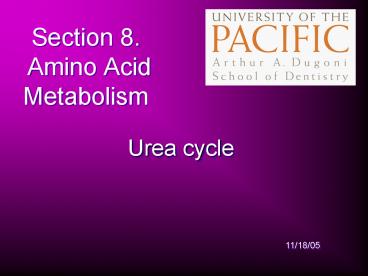Section 8. Amino Acid Metabolism - PowerPoint PPT Presentation
1 / 18
Title:
Section 8. Amino Acid Metabolism
Description:
Section 8. Amino Acid Metabolism Urea cycle 11/18/05 Substrates for the Urea Cycle Above, amino groups are transferred to glutamate, from which ammonium is produced ... – PowerPoint PPT presentation
Number of Views:288
Avg rating:3.0/5.0
Title: Section 8. Amino Acid Metabolism
1
Section 8. Amino Acid Metabolism
- Urea cycle
11/18/05
2
Substrates for the Urea Cycle
- Above, amino groups are transferred to glutamate,
from which ammonium is produced, and then used to
make carbamoyl phosphate. - Below, amino groups are transferred to produce
aspartate.
1
3
Urea Cycle
- Aspartate and carbamoyl phosphate each deliver an
amino group to the cycle. - Notice that the carbamoyl phosphate production
and condensation occur in the mitochondrial
matrix.
Fig. 23.16
2
4
NH4 from Oxidative Deamination of Glutamate
- Hexameric glutamate dehydrogenase is is
controlled allosterically. - High energy levels inhibit (ATP and GTP).
- Low energy levels activate (ADP and GDP).
- NADP can replace NAD.
- NH4 , which is toxic to humans, is produced in
the mitochondria and used to make carbamoyl
phosphate.
3
5
Carbamoyl Phosphate Synthesis
(p. 645)
- Carbamoyl phosphate synthetase is in
mitochondrial matrix. - NH4 is source of NH3.
- The hydrolysis of two ATP make this reaction
essentially irreversible. - N-acetyl glutamate is an allosteric activator.
(see S08L05)
4
6
2 P used
- 1. ARGININOSUCCINATE SYNTHASE 2.
ARGININOSUCCINASE - 3. ARGINASE
4. ORNITHINE TRANSCARBAMOYLASE
5
7
Connection to Krebs Cycle
- Fumarate is oxidized to oxaloacetate by Krebs
cycle enzymes, producing NADH. - Oxaloacetate accepts an amino group instead of
being condensed with acetyl CoA.
6
8
Amino Acids to Urea
- Glutamate Dehydrogenase is the control site
ADP (), GDP (), ATP (-), GTP (-) and
NADH (-). - Control at other sites by glucagon (), cortisol
(), insulin (-), growth hormone (-).
7
9
Summary of Reactions and Energetics - 1
- H20 aa NAD ? ?-keto acid NH4 NADH H
- and
- H20 fumarate aa NAD ? aspartate ?-keto
acid NADH H - then
- aspartate NH4 HCO3- 3 ATP ?
- urea fumarate 2 H20 2 ADP AMP 4 Pi
H - Four high energy phosphate bond equivalents are
used for these reactions (- 4 P). - Two NADH are produced.
8
10
Summary of Reactions and Energetics - 2
- Now consider NADH oxidation
- 2 H 2 NADH O2 ??2 NAD 2 H20 (5
P) - The net reaction is then
- 2 aa HCO3- O2 ?
- 2 ?-keto acid urea H 2 H20
(1P)
9
11
Hyperammonemia
- Normal blood NH4 is 10-40 mM.
- Deficiencies of carbamoyl phosphate synthetase or
of any enzyme in the urea cycle cause high
NH4. - Affects CNS and can lead to irreversible brain
damage. - Treatment strategies depend on which enzyme is
deficient.
10
12
Argininosuccinase Deficiency
- Low dietary protein reduces need for urea cycle.
- High dietary arginine provides a path for
carbamoyl phosphate and aspartate nitrogens to
produce argininosuccinate, which is excreted.
11
13
Carbamoyl Phosphate Synthetase Deficiency
Fig. 23.20
- Hippurate and phenylacetylglutamine are excreted.
- Amino groups to glycine and glutamine by
transamination.
12
14
Ketogenic and Glucogenic Amino Acids
Fig. 23.21
- After removal of the amino group, the keto acids
are used to make Krebs cycle intermediates,
pyruvate, acetyl CoA and acetoacetyl CoA.
13
15
Nitrogen for Oral Bacteria
- Urea is a major source of nitrogen for oral
bacteria. - It diffuses through most membranes and is in
saliva. - Bacterial urease produces NH4.
- Glutamate dehydrogenase incorporates NH4 into
?-keto acids to obtain?amino acids for bacterial
growth.
14
16
Nitrogen for Bacterial Amino Acid Synthesis
- When NH4 is limiting, it does not bind
glutamate dehydrogenase, and the lower two
reactions are used.
15
17
Engineered Oral Bacteria to Fight Caries?
- Streptococcus Salivarius urease activity affects
oral microbial ecology. - It produces NH3, which in addition to promoting
growth, neutralizes acids produces by other
bacteria. - S. Salivarius urease gene was introduced into
Streptococcus mutans GS5. It was expressed and
during glucose metabolism reduced pH decrease and
duration. - (Clancy Burne,1997 FEMS Microbiol Lett
151205)
16
18
- Web links
- Nitrogen Fixation. A summary of the topic.
- Nitrogen Cycle. The biological big picture.
- Amino Acid Metabolism. Reviews reactions.
- Next topic Porphyrins, heme, bile pigments































